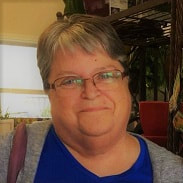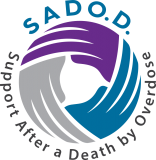
Podcast Host Learns to Talk About Grief
By Luke Schmaltz, VOICES Newsletter Editor
Kathy Gleason is the co-founder and host of the As I Live and Grieve Podcast. With the help of daughter Stephanie Kendrick, Gleason set out to examine, discuss, and confront grief after a lifetime of avoiding it.
With over 150 archived episodes and counting, Gleason delves into the vast world of grief through weekly conversations with authors, grief coaches, influencers, bloggers, public figures, and more. Each episode addresses grief in some way, yet the subject matter ranges across a wide array of topics such as stigma, thriving after loss, survivor’s guilt, pet loss, spiritual beliefs, and coping through the holidays – to name just a few.
“It is really tough to bring your grief out and ask for support. I used to avoid any conversation or contact with death and dying. It terrified me to think of not having someone around that had become a vital part of my life. Yet here I am – led, called, or otherwise directed to be a grief advocate.”
Death Without Mourning
“The very first loss in my life was when I was 10 years old,” Gleason says. “All I was told was that grandma had died, mom and dad were going to the funeral home to say goodbye, and I had to stay home.”
15 years later, as Gleason was engaged to be married, her father was diagnosed with cancer. “It was my fairytale wedding, and I wanted my dad to walk me down the aisle. Unfortunately, he was in the hospital and declining, so my brother gave me away and my dad died shortly after.”
“About two years later I was pregnant. When I went into labor, on the way to the hospital, I started feeling really sick and by the time I arrived I had spiked a fever of well over 104 degrees. Life-saving measures went into play, and although it was full-term, they decided to take the baby. In the delivery room, there was no cry, and I was waiting to get an Apgar score which is the measure of a newborn’s health. When I asked about it, I was told to relax, and I went to sleep only to wake up hours later to find out my baby was so ill they had whisked him off to a completely different facility. About 20 hours later, I was told the baby had died.”
“These were times when grief wasn’t handled at all. I don’t even think I knew the word ‘grief’ at that point. There were no bereavement groups, there were no therapists, really. You just kind of sucked it up and moved on. So, that’s what I did.”
Avoiding the Inevitable
“About 15 years ago, my mother reached the age of 91 and started to decline. Her death was called ‘failure to thrive.’ I think she just got tired of trying to stay well. At the time, I was working in a nursing home – the very home she was a resident of. Regardless, I was terrified to even talk about death. I wanted nothing to do with it.”
My mother was an inveterate planner, and she had all the details of her death, her funeral, and her graveside service planned to the minutest detail so that it wouldn’t be a burden on my brother and me. Even so, every time she wanted to talk about it, I would make an excuse and not show up for that conversation.”
“The most recent loss, and probably the one that has been the hardest, was that of my husband, which happened five-and-a-half years ago. He died just before our 12th anniversary. Tom and I had known each other for about 20 years. At one point, our kids were dating – that’s how we met. It wasn’t one of those high school romances, but I do feel he was my soul mate. It took me a long time to find him and for him to find me. That loss was very difficult.”
Learning to Accept
While her husband was ill, Gleason was working at a hospice in an administrative role. She took comfort in the fact that her office was in the basement, and she wouldn’t have to work near all of the death and dying. “It was obvious to the people working there that I was struggling with the whole issue of death, especially as my husband was becoming more and more ill and requiring more and more care.”
“One day, one of the nurses came down and said she needed help with a resident, but she couldn’t do it by herself. She needed somebody, as she turned the patient over, to simply hold them in position while she took care of them. So, I did that and over time she would come down and ask me for help more and more.”
“Each time it would get a little bit more involved. It was through that process, by way of that wonderful nurse, that I eventually became more comfortable with the idea of someone dying and me being present to experience it. It was the staff at that comfort care home that helped me overcome my fear of death and my fear of talking about death. We started a bereavement group, and they asked me to facilitate it, which I did.”
Fulfilling Inspiration
Gleason’s bereavement group was interrupted by the pandemic, yet her desire to help others persisted. Rather than start up again, however, she wanted to do something different, bigger, and more rewarding. “One day I was chatting, and my daughter was there,” she begins. “I was saying, ‘There are so many more people who need help, so many more people who need to talk about death and how it is affecting them.’ Then somehow, call it divine intervention, into my head came the word ‘podcast.’ I knew nothing about it. I had never listened to a single podcast. I just knew what they were.”
“My daughter said, ‘I’ll help you, mom.’ We did our research, and six weeks later we launched our first five episodes. That was almost three years ago.”
“It wasn’t until recently, when I was doing this podcast, when it occurred to me that I had never grieved for my father or my infant son. So, I am processing those deaths now, especially that of my baby whom I never saw, I never got to hold, and no one ever took a picture of.”
“The podcast has helped me grow in my knowledge of death and to ask a lot of questions. I have healed, I have redefined my life, and I am probably happier at this point in my life than I have ever been before.”
